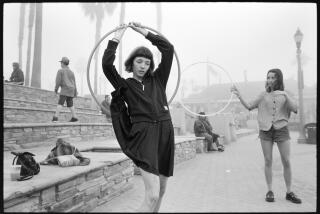Remembering Edmund Teske, a Poet-Pioneer of Photography
To visit Edmund Teske’s studio on Harvard Boulevard in the heart of Hollywood, where he lived for 20 or more years before I first got there, was an unforgettable experience. Its style was an only-in-L.A. combination, somewhere between a Buddhist temple and Bohemian garret. What little furniture he had was mostly handmade--inspired by Frank Lloyd Wright’s late plywood designs for Hollyhock House. Books and photographs were the main furnishings. He lived like an artist and spent his life proving he was not just an artist but a very good one. When I first heard his name in New York, it was in the context of Diebenkorn, Francis and Berman--L.A. painters and sculptors who had done something so original they were shown and talked about across the continent.
I was introduced to Teske by the photographers Robert Heinecken and Darryl Curran on a visit here in about 1975. I acquired Teske’s photographs for the Metropolitan Museum of Art and mentioned his name to Sam Wagstaff--New York’s most important collector of photographs--who soon added a dozen pieces to his collection (now in the collection of the Getty Museum). Teske’s photographs were the antithesis of the New York school of gritty documentation and stood out for the skillful way in which the imagination and reality were joined and overlaid. Rather than being slices through a single instant of time, they plumbed the memory and evoked different times and places, like dreams you can touch.
Teske was born in Chicago in 1911 but drew his inspiration from many sources. In the spring of 1936 he traveled from his home in Chicago to New York, where he met Alfred Stieglitz and Georgia O’Keeffe at Stieglitz’s gallery, An American Place. Encouraged by Stieglitz, Teske returned to Chicago in mid-1936 and was invited by Wright to take up residency at the Taliesin Fellowship in Spring Green, Wis., where he introduced photography as art to the other students. Meetings with Stieglitz and Wright--acknowledged geniuses in their respective fields of creative activity--set the stage for a brilliant career in art.
In 1939 Teske spent several months in New York, where he worked for Berenice Abbott. About this time Teske saw Man Ray’s Surreal photographs and soon began to experiment with ways for the final images to contain both positive and negative elements, which Teske likened to the yin and yang of Zen philosophy.
*
In 1943 Teske moved to Hollywood with the hope of one day becoming an actor, but he never gave up art. Soon after arriving here, he connected with a client of Wright’s, Aline Barnsdall, who some 25 years earlier had commissioned the architect to design a grand residence on Olive Hill, a 36-acre site in the middle of Hollywood, which she donated to the city and which today is a lively cultural center.
For several years, Teske lived in one of the abandoned art studios, using the environment he found there as his chief subject. Central to Teske’s lasting contribution as a photographer after he left the Barnsdall studio in the mid-1950s was the process of returning to negatives that were created sometimes decades earlier and joining them with recent work to form a new composite image from two or more negatives.
In the early 1960s, Teske pursued ways to manipulate both negatives and prints to achieve startling images. He explored the extreme limits of photographic “emulsion as plastic pigment” (his words) and his most coveted prints achieved luscious burnt umber tones and very painterly effects. The technique of how to achieve two or more separate colors during the process of developing an otherwise standard black-and-white print became Teske’s signature.
Through his manipulations of both negatives and prints, Teske succeeded in turning back the mental clock, as though they were arrested dreams. Teske traveled in the realm of the imagination and persistently avoided linear thinking in favor of the poetically irrational.
The work has the distinct mark of California--specifically Hollywood--by the graceful way it heroizes friends like Kenneth Anger by placing him in a larger-than-life fictional setting filled with an otherworldly atmosphere that recalls motion pictures. Teske returned again and again to a major summary of his work in the sequence of photographs that he called “The Song of Dust.” Its final manifestation with a new title was laid out in his studio for a final review the week he died--a fitting and poignant end for one of the geniuses of our time.
He will be greatly missed but not forgotten. Teske will enter the history books as the grand master of a style of picture that is taken for granted now that computers have created ways to cut and paste images seamlessly.
More to Read
The biggest entertainment stories
Get our big stories about Hollywood, film, television, music, arts, culture and more right in your inbox as soon as they publish.
You may occasionally receive promotional content from the Los Angeles Times.










